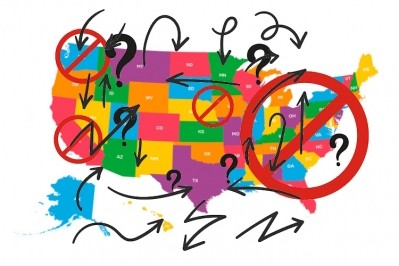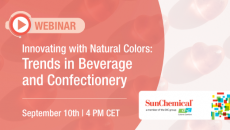Preparing for food-dye bans: What CPG brands must know about reformulations ahead of mandates

“If these proposed state-level food additives bans are passed into law, food and beverage companies will be faced with the challenge of determining the impact to their products, supply chains and businesses as these contradicting patchwork policies between federal and state regulators not only undermine consumer trust but will create challenges in terms of interstate distribution,” Bryan Hitchcock, chief science and technology officer at the Institute of Food Technologists, told FoodNavigator-USA.
The emerging patchwork of laws on food additives
Last year, California passed its Food Safety Act and banned brominated vegetable oil, potassium bromate, propylparaben and Red Dye No. 3 from foods and beverages made and sold in the state. Food and beverage companies have until Jan.1, 2027, to comply with this state law.
Separately, in May, California legislators advanced AB-2316, which if signed into law could ban seven food dyes — including Red Dye No. 40, Yellow Dye No. 5 and 6, Blue Dye No. 1 and 2 and Green Dye No. 3 — and titanium dioxide from school meals.
In April 2024, Illinois came one step closer to banning five ingredients — the four ingredients from the California ban and titanium dioxide — with the passage of the Illinois Food Safety Act, SB2637 in the state senate. If signed by Illinois Governor J.B. Pritzker, food and beverage manufacturers will have until 2028 to reformulate their products.
Proponents of these bills — including the Center for Science in the Public Interest— argue that food additives like Red Dye No. 3 are carcinogenic and dangerous to human health per animal studies, and opponents of these bills argue that the additives have years of research and testing to confirm its safety.
"Many of the food dyes used in the US have been used for decades. The safety of these food additives continues to be researched and evaluated by global regulatory bodies and reputable scientific institutions. As dietary patterns and consumption patterns shift, exposure and frequency to food dyes changes. Continuously reviewing these shifts for significant changes that may impact health is an essential component to food safety,” Hitchcock said.
How many products will be impacted by the legislation?
In the US, approximately, 16% of candies, gums and mints; 15% of sweet snacks and 12% of cookies and crackers contain Red Dye No. 3, and regulations can impact more than 5,000 individual items, according to NIQ data for the 52 weeks ending April 6.
Additionally, 28% of sweet snacks, 16% of candy, gum and mints and 7% of desserts in the US include titanium dioxide, with current food-additive bans potentially impacting more than 7,000 SKUs, according to the same data.
Some CPG brands have already made changes to comply with various statewide bans. Last fall, the manufacturer of the popular marshmallow candy PEEPS, Just Born, shared that it will no longer use Red Dye No. 3 in any of its candies after Easter 2024 to comply with the California law.
CPG companies “may opt to discontinue a product or in the case of the Illinois Food Safety Act, stop distributing to Illinois altogether” or other states with these bans due to the cost of reformulation and compliance, Hitchcock noted.
“A state like Illinois enacting food safety legislation that conflicts with FDA regulations reinforces the need for integrating modern science and technology into the global food supply and its governance. Ultimately, we need to unite behind science when enacting this type of legislation. If we want to enact impactful food legislation to better protect consumers, government at the state and national level must work together more effectively,” Hitchcock said.
‘Compliance with these bans is going to be costly’
Proponents of these food-additive bans often point out that versions of these products without the banned ingredients exist in other countries. However, bringing these formulations to the US is not an easy process and might require costly supply-chain changes and extensive consumer testing, Hitchcock noted.
“Even when alternative ingredients and products exist in other regions, evaluations are required to ensure [they] are readily available and transferrable. Compliance with these bans is going to be costly. It will include researching alternative ingredients, developing and testing alternative products, navigating higher ingredient costs, designing new labels and setting up new supply chains,” Hitchcock said.
He added, “The impact also goes well beyond the costs associated with reformulation. As time and resources are limited, complying with conflicting legislative and regulatory requirements also diverts resources away from other critical food safety, nutrition and sustainability priorities.”
The color of a product is not only important from a branding perspective, but it also influences the sensory experience of a product, Ruy Elias Estrada, global business leader of natural colors at IFF, told FoodNavigator-USA.
“Ninety percent of a consumer’s assessment of food is based on color. Color can alter one’s overall sensory experience, by increasing or diminishing sweetness, saltiness or spiciness perception,” Elias said.
IFF: ‘The world today is trending more towards cleaner labels’
Ingredient companies like IFF, DSM, Sensient Technologies, ADM, Kalsec and others offer a range of natural colors that can replace artificial dyes and expertise to assist in the reformulation process.
When reformulating products, CPG brands need to consider a host of obstacles from how the natural dye mixes with other ingredients in the formulation, including flavors, said Elias.
“All natural color types have specificities, and there is no universal replacer for colors, hence matching natural colors exactly to artificial dyes can be challenging. Another aspect to consider is [a color’s] stability throughout the process and shelf-life. Colors from natural sources tend to be less stable and typically have shorter shelf life. This can also mean higher costs involved from formulating the product to ensure it maintains its color, quality and appeal to customers,” he added.
IFF offers a range of natural colors that can be used to create "most of the rainbow shades in different applications, using various delivery technologies from liquid formulations to encapsulated powders," Elias said.
For instance, CPG brands can use carmine — a natural color extracted from cochineal insect — or red beet in place of Red Dye No. 3 in confectionery applications, he elaborated.
"Some key factors to be considered in selecting and using natural color formulations include solubility (water or oil soluble/dispersible versions), its physical form (liquid or powder versions adjusting to production line requirements), acidity or pH levels, whether heat treatment is present, [and] interaction with other ingredients,” Elias said.
Despite the cost of natural colors, consumer trends might push CPG brands to consider reformulations, Elias noted.
“On the positive side, the world today is trending more towards cleaner labels. Natural ingredients and colors are gaining popularity. As the market is trending natural, manufacturers need to catch up with the trend while looking for affordable solutions. Consumers want the full package — good for me, sustainable, look and taste,” he added.
Unreal CEO shares a natural approach to food colors
While some brands will wait and see if regulations will push them to reformulate, natural candy brands like UNREAL already have invested in and researched natural colors for its products.
“We launched our gems, and they are colored with colors from vegetables, spirulina, turmeric [and] beetroot, and we worked really hard to create those natural dyes to color the products in a really beautiful way,” UNREAL’s CEO Kevin McCarthy told FoodNavigator-USA.
“You can do the right thing from an ingredient perspective and be successful as a brand ... and have consumers love the product and love the taste. And with our natural dyes on our gems, we work really hard to make sure that those are the right ingredients and the right process. But we want people to look at our product and not even think about maybe a difference between how vibrant that color is. It takes a lot of work and a lot of care for the product, but ultimately, it is about caring for that consumer,” McCarthy said.
Additionally, UNREAL is educating consumers on natural and artificial dyes in foods, so they can decide what is healthier, he added.
“Many of these dyes are banned in other countries, [and] many people do not know that. It [might be] a product that they have grown up with and have consumed for years, and it is just part of their life. It is tough … to realize that you may have been consuming something that is not great for you. But it matters, and I think speaking to younger generations, especially kids, how can we create a generation where that is not the standard and move towards something that is better,” McCarthy said.


















